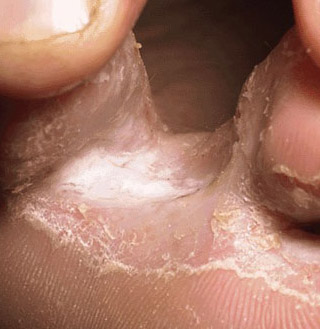The first reported case of tinea pedis in the United States was noted in Birmingham , Alabama United States
Athlete's foot called this way because it's occur mostly in athlete's people , not because it's only occur in athlete's !
It's cause by Tinea pedis .. a type of fungal infection , causes scaling, flaking, and itch of affected areas.
Although the condition typically affects the feet, it can spread to other areas of the body, including the groin. Athlete's foot can be treated by a number of pharmaceutical and other treatments.
Athlete's foot can usually be diagnosed by visual inspection of the skin, but where the diagnosis is in doubt direct microscopy of a potassium hydroxide preparation may help rule out other possible causes, such as eczema or psoriasis. A KOH preparation is performed on skin scrapings from the affected area. The KOH preparation has an excellent positive predictive value, but occasionally false negative results may be obtained, especially if treatment with an antifungal medication has already begun
The fungi that cause athlete's foot can live on shower floors, wet towels, and footwear, and can spread from person to person from shared contact with showers, towels
Without medication athlete's foot resolves in 30–40% of cases and topical antifungal medication consistently produce much higher percentages of cure
Tinea pedis can be treated with topical or oral antifungals or a combination of both .
The need for follow-up care in tinea pedis should be assessed on a case-by-case basis. Further outpatient visits may be indicated, depending on the extent and severity of the tinea pedis. Treatment regimens may need to be switched or augmented
Recourse : emedicine. wikipedia
History Of Tinea Infection
In the ancient world, many diseases caused by fungi were well known but were ascribed to different causes. The Romans, for example, recognized the disease that we call ringworm but attributed it to infestation with small insects. They called the infection “tinea”, which refers to small insect larvae. This attribution survives in the medical designations of the fungal diseases ringworm (tinea capitis), jock itch (tinea cruris),
and athlete’s foot (tinea pedis)—each of which is caused by one or more fungal species.
In 1791, M. Plaignaud first reported anecdotally a fungal infection of the sinuses, although it was not until 1885 that Schubert gave a complete clinical description of the
disease, showing it to be caused by an Aspergillus species.
In 1888, C. Pellizari described the first case of athlete’s foot, tinea pedis, which was not recognized in Europe until 1908. The
disease, caused by a fungus endemic to Southeast Asia —Trichophyton rubrum— was considered at the time to be rare. It
spread through Europe (one might postulate as a revenge for colonialism), and today it is considered the most common fungal
disease in the world, estimated to infect, at one time or another, 70% of the human population. The fungal lung disease histoplasmosis was first identified in 1905 in the Panama
Canal Zone, although it was not until 1934 that W. A. DeMonbreun of Vanderbilt University
until a massive X-ray program as part of the military draft in the United States
healed-over pulmonary lesions. Modern estimates hold that approximately 20% of the U.S.
